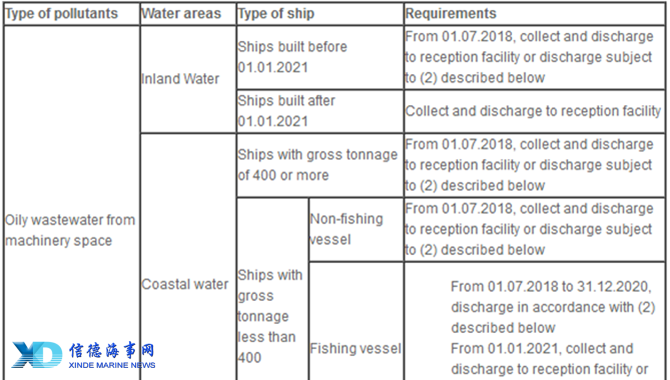
| Type of pollutants | Water areas | Type of ship | Requirements | |
| Oily wastewater from machinery space | Inland Water | Ships built before 01.01.2021 | From 01.07.2018, collect and discharge to reception facility or discharge subject to (2) described below | |
| Ships built after 01.01.2021 | Collect and discharge to reception facility | |||
| Coastal water | Ships with gross tonnage of 400 or more | From 01.07.2018, collect and discharge to reception facility or discharge subject to (2) described below | ||
| Ships with gross tonnage less than 400 | Non-fishing vessel | From 01.07.2018, collect and discharge to reception facility or discharge subject to (2) described below | ||
| Fishing vessel |
|
|||
| Oily wastewater containing oil cargo residues | Inland water | All oil tanker | From 01.07.2018, collect and discharge to reception facility | |
| Coastal water | Oil tanker with gross tonnage of 150 or above |
From 01.07.2018, collect and discharge to reception facility, or discharge during navigation when complying with below requirements:
|
||
| Oil tanker with gross tonnage less than 150 |
From 01.07.2018, collect and discharge to reception facility |
|||
| Pollutant | Limitation | Monitoring location |
| Petroleum (mg/L) | 15 | Water outlet of oily wastewater processing unit |
| Waters areas | Control requirement |
|
3Nautical miles<distance from the nearest shore≤12 Nautical miles |
Both below requirements should be satisfied: (1) usingequipment to break solids and then discharge after disinfection (2) navigating speed not less than 4 knots, and the discharge rate of sewage not exceed the maximum discharge rate of the corresponding speed. |
|
distance from the nearest shore >12 Nautical miles |
Navigating speed not less than 4 knots, and the discharge rate of sewage not exceed the maximum discharge rate of the corresponding sailing speed. |
| No | Pollutants | Limits | Monitoring location |
| 1 | BOD5 (mg/L) | 50 | Water outlet of sewage treatment facility |
| 2 | Suspended matter(SS)(mg/L) | 150 | |
| 3 | Heat resistant coliform group(Piece/L) | 2500 |
| No | Pollutants Items | Limits | Monitoring location |
| 1 | BOD5 (mg/L) | 25 | Water outlet of sewage treatment facility |
| 2 | Suspended matter(SS)(mg/L) | 35 | |
| 3 | Heat resistant coliform group(Piece/L) | 1000 | |
| 4 | CODcr (mg/L) | 125 | |
| 5 | PH(Dimensionless) | 6-8.5 | |
| 6 | Total chlorine (mg/L) | <0.5 |
| No | Pollutants Items | Limits | Monitoring location |
| 1 | BOD5 (mg/L) | 20 | Water outlet of sewage treatment facility |
| 2 | Suspended matter(SS)(mg/L) | 20 | |
| 3 | Heat resistant coliform group(Piece/L) | 1000 | |
| 4 | CODcr (mg/L) | 60 | |
| 5 | PH(Dimensionless) | 6-8.5 | |
| 6 | Total chlorine (mg/L) | <0.5 | |
| 7 | total nitrogen (mg/L) | 20 | |
| 8 | ammonia nitrogen (mg/L) | 15 | |
| 9 |
total phosphorus (mg/L) |
1.0 |
| The waste water contains any of the following toxic liquid substances. | Discharge control requirements |
|
(1)substances of category X (2)high viscosity or solidified substance of category Y (3)substances of category Ywhich have not been discharged according to the prescribed procedures (4)substances of category Zwhich have been discharged according to the prescribed procedures |
If the prewashing can not be exempted, ship should conduct prewashing according to the relevant procedures before leaving the port of discharge, and the prewashing water of holds should be discharged to the reception facility. The concentration of substances of category X should be reduced to less than or equal to 0.1% (mass percentage) after prewashing. After the concentration has reached above requirement, the remaining sewage should be discharged to the reception facility until the hold is empty. After prewashing, the waste water containing noxious liquid substances generated from further water injection should be discharged according to 4.2 of this standard. |
|
(1)substances of category Y that have been discharged according to the prescribed procedures (2)substances of category Z that have been discharged according to the prescribed procedures |
In accordance with requirement under 4.2 of this standard. Ship that built before 01.01.2007 can be exempted from the requirement under 6.2C) of this standard when discharging waste water containing substances with category Zor provisional discharging waste water containing substances with category Z. |